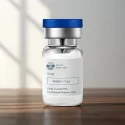Cagrilintide
- Cagrilintide represents a new generation of anti-obesity therapy targeting the amylin pathway, a crucial component of appetite and energy balance.
- Its dual benefits—effective appetite suppression and enhanced satiety—make it a valuable tool for long-term weight management.
- When combined with GLP-1 agonists such as semaglutide, Cagrilintide offers synergistic metabolic effects, marking a major advancement in the fight against obesity and related metabolic diseases.
- 10 Vials
Name :Cagrilintide
CAS:1415456-99-3
Form:Powder
EINECS:206-141-6
Appearance: Powder
Purity: >99% (or refer to the Certificate of Analysis)
Shipping Condition: Shipped under ambient temperature as non-hazardous chemical. This product is stable enough for a few weeks during ordinary shipping and time spent in Customs.
Storage Condition: Dry. dark and at 0 – 4 C for short term (days to weeks) or -20 C for long term (months to years).
Solubility: To be determined
Shelf Life: >2 years if stored properly
Stock Solution Storage: 0 – 4 C for short term (days to weeks). or -20 C for long term (months).
What is Cagrilintide?
Cagrilintide is a novel, long-acting amylin analogue developed by Novo Nordisk for the treatment of obesity and metabolic disorders.
It mimics the natural hormone amylin, which is co-secreted with insulin by pancreatic β-cells and plays an essential role in appetite regulation, gastric emptying, and glucose metabolism.
Cagrilintide is designed as a once-weekly injectable peptide that promotes weight reduction by enhancing feelings of fullness (satiety) and reducing overall food intake.
Mechanism of Action
Amylin is a naturally occurring peptide that helps regulate food intake and blood glucose by acting on specific receptors in the brain’s hypothalamus and gastrointestinal tract.
Cagrilintide, as a stable and long-acting amylin receptor agonist, reproduces these physiological effects more effectively and with a longer duration of action.
Its key mechanisms include:
-
Suppressing appetite — reduces hunger and promotes satiety through activation of amylin and calcitonin receptors in the brain.
-
Slowing gastric emptying — delays digestion and nutrient absorption, helping control post-meal glucose levels.
-
Decreasing caloric intake — supports long-term weight reduction and fat mass loss.
-
Improving metabolic balance — enhances overall energy regulation without causing hypoglycemia.
When used in combination with other metabolic drugs such as semaglutide (a GLP-1 receptor agonist), Cagrilintide has shown additive effects on weight loss and appetite control.
Clinical Benefits
Results from clinical trials, including the AM833 and CagriSema studies, demonstrate that Cagrilintide can:
-
Induce significant and sustained weight loss, both alone and in combination with semaglutide
-
Reduce caloric intake and food cravings
-
Improve metabolic parameters, including blood glucose and lipid profiles
-
Enhance patient satiety and adherence to lifestyle interventions
In combination therapy (Cagrilintide + Semaglutide), average body-weight reduction exceeded 15–20%, showing potential as one of the most effective pharmacological approaches for obesity management.
Administration and Dosage
-
Formulation: Once-weekly subcutaneous injection.
-
Dosing range: Typically 0.3 mg to 4.5 mg weekly, titrated gradually based on tolerance and clinical response.
-
Use: Can be used as monotherapy for weight management or combined with GLP-1 receptor agonists for enhanced efficacy.
Safety and Tolerability
Cagrilintide is generally well-tolerated.
Common side effects include:
-
Mild to moderate nausea or vomiting (usually transient)
-
Decreased appetite
-
Constipation
-
Injection-site discomfort
No significant hypoglycemia has been observed when used without insulin.
The safety profile is comparable to or better than that of other incretin-based weight-loss agents.





